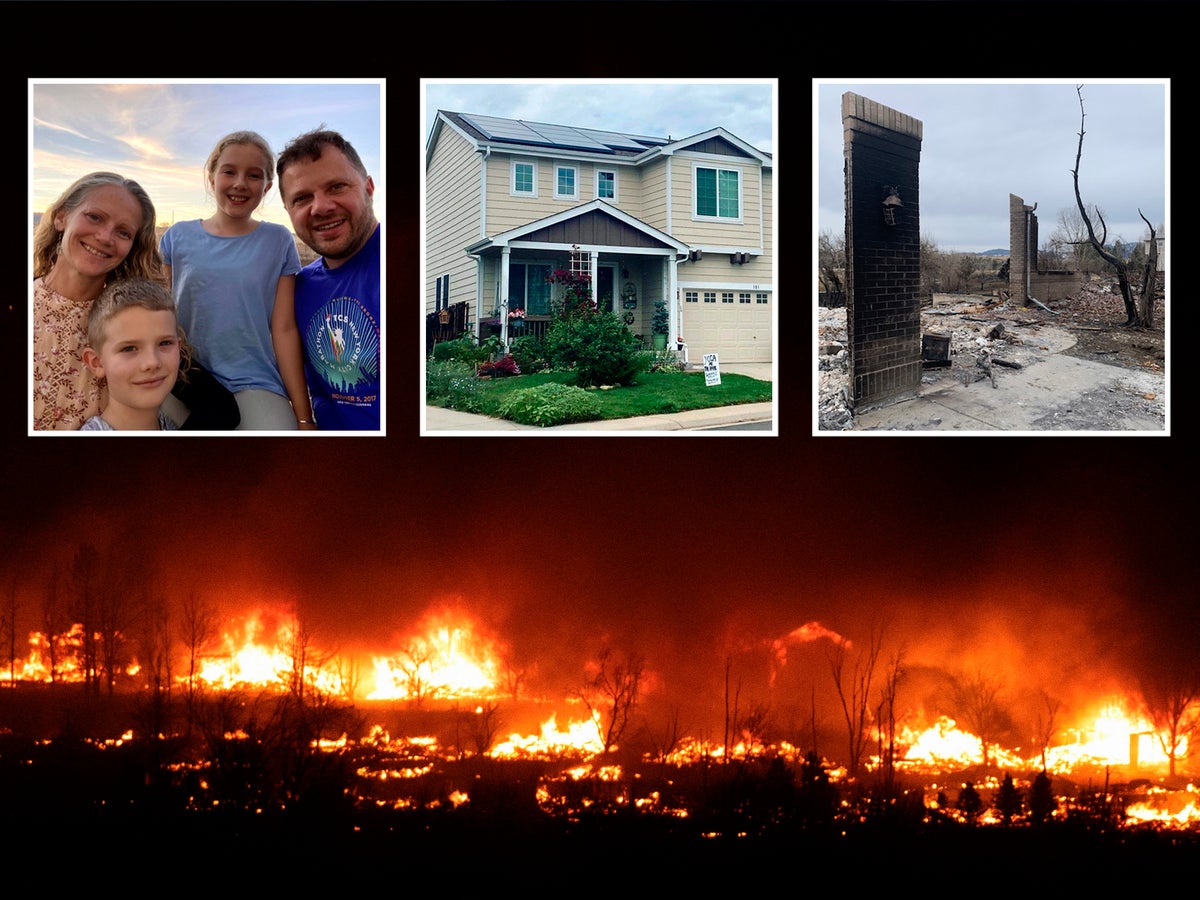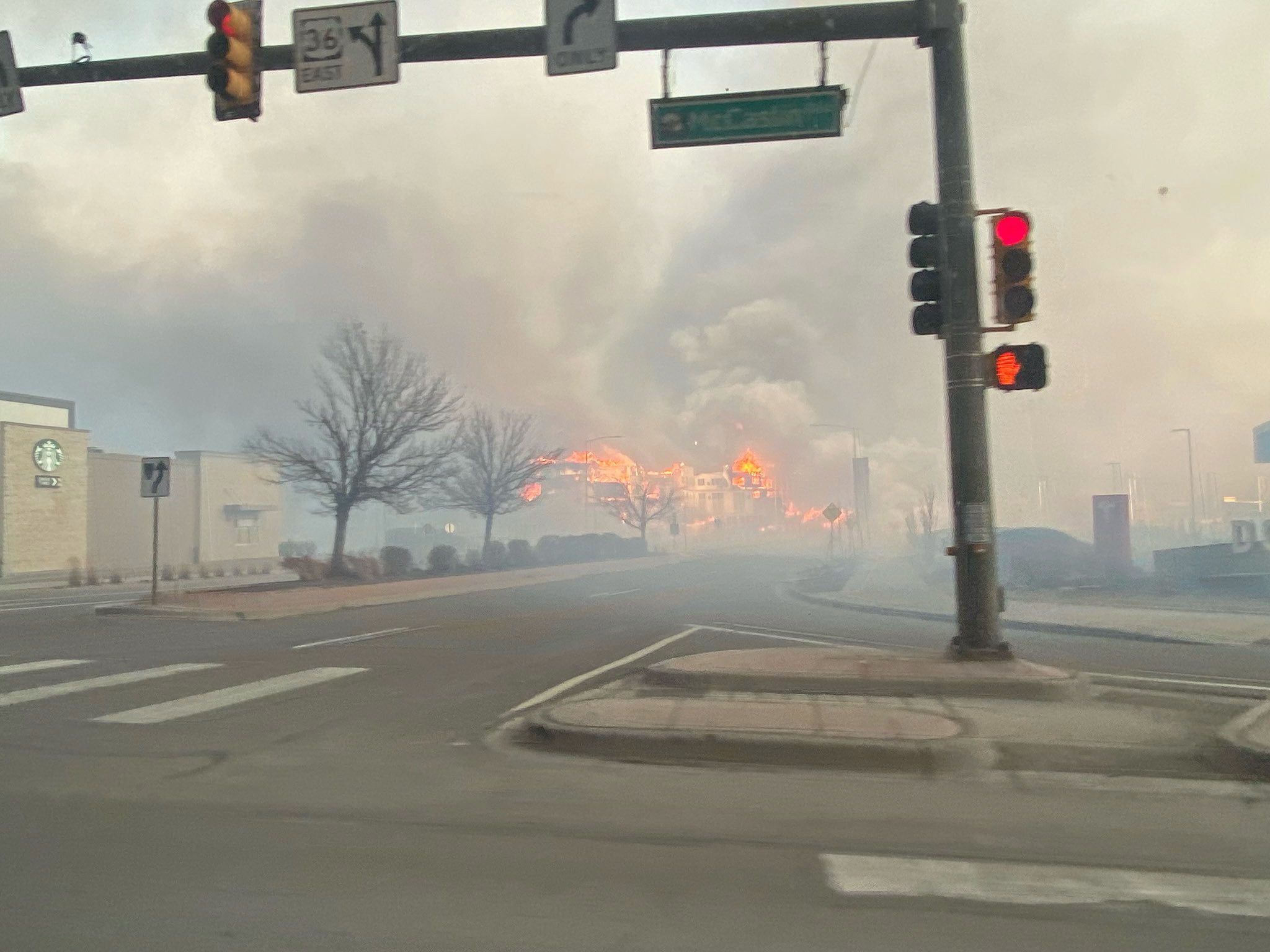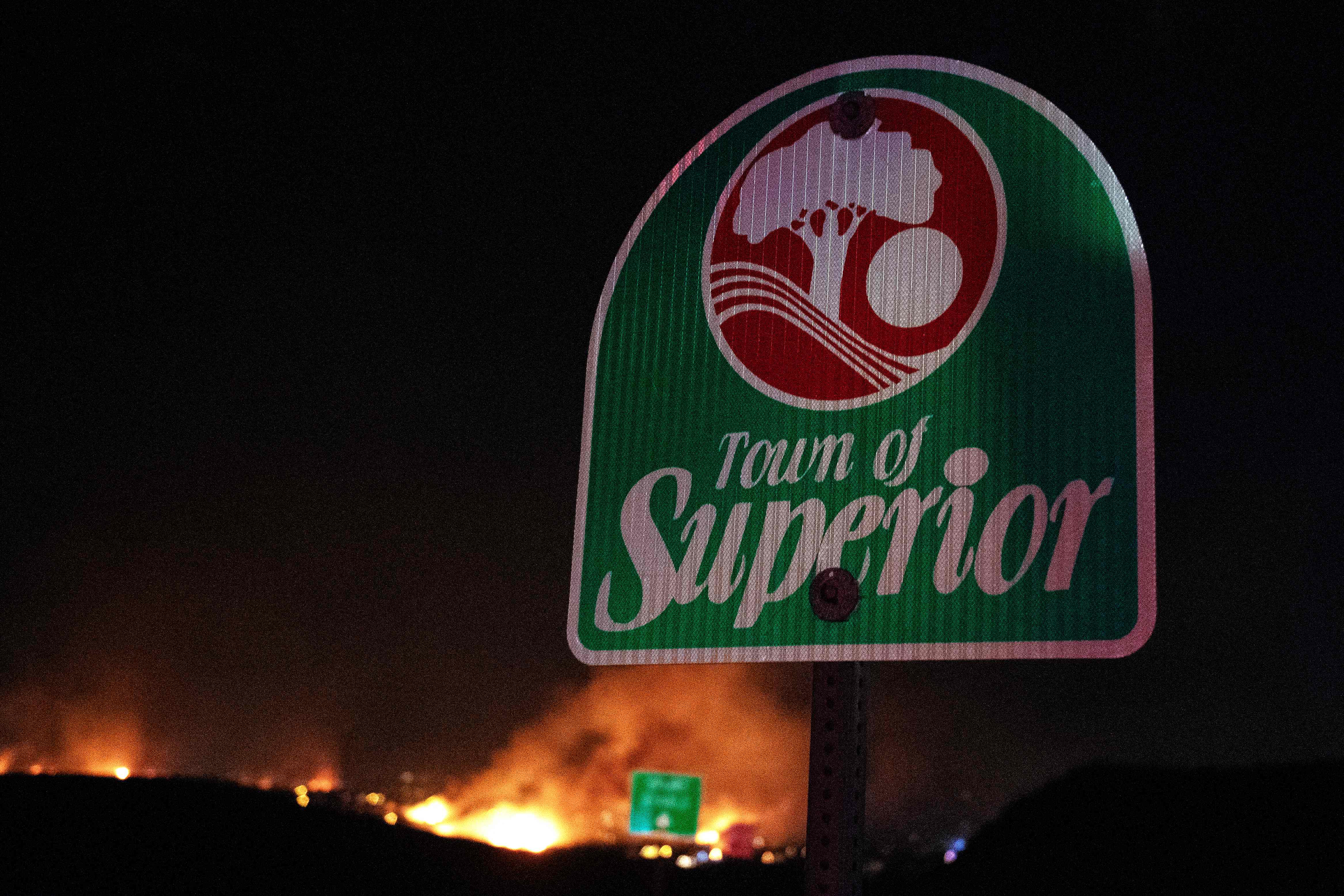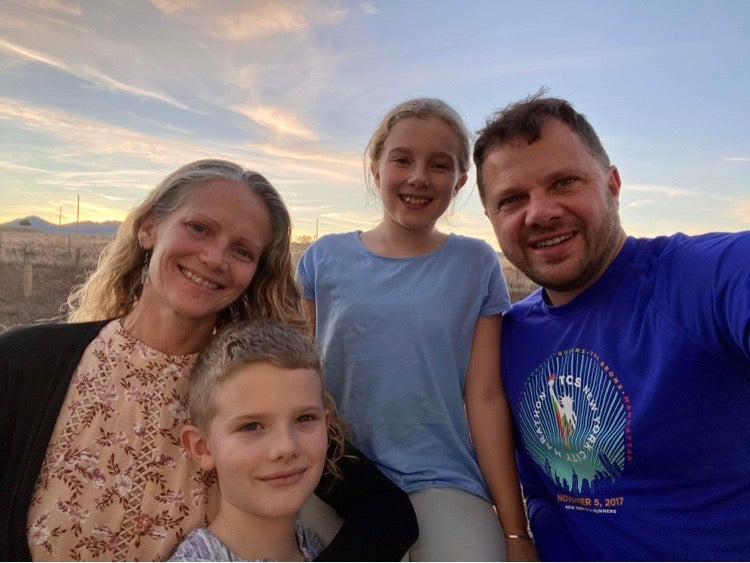
Exactly 11 days before the first anniversary of the Marshall Fire – the most devastating blaze in the history of Colorado – the flames came back.
The wind, again, whipped up, the smell and sight of smoke permeating Boulder County in an eerie replication of conditions that last holiday season left two dead and more than 1,000 homes destroyed. Residents already grappling with trauma and flashbacks watched as their fiery nightmares materialised, literally, before their eyes.
Mel Glover was Christmas shopping with her 13-year-old daughter, who’d barely made it out of the family’s house last December in Superior – less than a half-hour northwest of Denver. Ms Glover’s husband, Matteo, had fled in just the nick of time with their two children and two dogs through “120-mile winds filled with fire, ashes and flying” debris that he described as “like a demon,” she tells The Independent.
Their beloved house was destroyed in the heavily hit subdivision of Sagamore, a section so infamous locally now that its mere mention elicits sympathetic headshakes. The family had no time to save their cat and guinea pigs; Ms Glover struggles with guilt, has been receiving therapy ever since and still cries “two to three times a day”. Her son and daughter have been more stoic – or so she thought, until Zoe found out about the fire last week.
“She kind of sets the emotions aside, and she was bawling,” Ms Glover says of her daughter, who turns 14 next month. “And of course, we were Christmas shopping, and Christmas is hard enough as it is, because the fire was just after Christmas.”

The Sunshine Wildland Fire – which destroyed one home and damaged another but thankfully caused no injuries – not only brought back traumatic memories but prompted new panic.
“We were like, ‘Do we go home? Are we gonna get the dogs? Is it going to be okay?’” Ms Glover tells The Independent.
The feverish worries going through her family’s heads were being replicated in real time on social media by neighbours and other traumatised victims of last year’s fire. Members of one Facebook forum, in particular, were sharing their innermost thoughts and fears, interspersed with conversations about everything from insurance claims to donation sites. The Marshall Fire Community group was established in the immediate aftermath of the fire by a physician assistant in a Denver suburb unaffected by the disaster – but it quickly burgeoned into a grassroots support system that now has its own website and reputation.
“It’s almost like you could see people going through the stages of grief,” says Meryl Suissa, 36, who’d originally hoped to create a “buy nothing”-style group for survivors, volunteers and donors. Within weeks, the group had more than 4,000 members, continued to grow and “became much more involved than that” as she worked 20 hours a day to bridge gaps between official aid and desperate victims on the ground.
“There’s no ‘disaster central’ after any disaster,” says Ms Suissa, who’d happened to do casual research on her own after reading about the wildfires in California several years ago. “Boulder County, they’ve dealt with floods before, they’ve dealt with fires. [But] no matter how much you think you’ve learned from the prior disaster ... A disaster on this scale was, I think, nothing anyone ever imagined.”
Everyone, indeed, was unprepared for and surprised by the Marshall Fire, a consequence of myriad factors that combined to spark the perfect firestorm. The Front Range had experienced above average rainfall earlier in the year, leading to tall grass standing 3-4 feet high, according to a Facilitated Learning Analysis of the blaze led by the Colorado Division of Fire Prevention and Control. Dry winter conditions in the run-up to the holidays meant that tall grass hadn’t been packed down - providing perfect fodder when a wildfire (the official cause of which remains under investigation) broke out on 30 December 2021.

“Driven by wind gusts of up to 115 miles per hour, it swept through subdivisions and commercial buildings in the communities of Louisville and Superior and over a six-lane highway,” the analysis found. “Firebrands and flaming debris were carried ½ mile in front of the main fire. Firefighters, law enforcement officers, utility crews and volunteers worked inside the smoky fire perimeter, sometimes in piecemeal safety gear. Helmets and eye protection were stripped off by the wind, doors were bent back, and rocks, wood and sheet metal shattered the glass in emergency vehicles.”
The wind was “severe” but no longer “an anomaly,” according to the report.
“The Front Range of Colorado and other parts of the United States have all seen the same weather phenomenon play out with enough regularity that is warrants emphasis in the wildland fire community,” the analysis states. “Without the impacts of drought and multiple other environmental factors that set the stage for the fire to ignite and spread, the wind event would have been a non-factor. Put another way, the Marshall fire occurred between Christmas and New Year’s Eve, two holidays that most Americans and the wildland fire community associate with family, snow, and anything but extreme fire behavior.
“The wildland fire community is in the midst of adapting to this shift, which includes responding to weather patterns and recognizing volatile conditions during a part of the year we have few slides for.”
Earlier this month, when US Deputy Secretary of the Interior Tommy Beaudreau announced $228m in federal funding to fight and recover from wildfires, he held the press conference in Colorado.
“Here we are, almost a year away from the Marshall Fire, which was incredibly destructive and happened in the dead of winter, which I think was a shock to all of us but is an indication of what’s going on in our planet and on our landscapes,” he said on 14 December at Rocky Mountain Arsenal National Wildlife Refuge.
As the Marshall Fire worsened last year, officials rushed through neighbourhoods with PA systems as 35,000 people were evacuated. The path of the fire was wholly unpredictable as it jumped with the wind; more than 1,000 pets were killed, according to University of Colorado research.
“Water failed in some areas, and the utility crews went to heroic lengths to keep the pressure up for firefighters,” the report details. “Propane tanks detonated over the shriek of the hurricane-force gusts, making the area sound like a war zone.”

It was in that “war zone” that Ms Glover’s husband and children found themselves last year. Less than a half hour before, she’d been taking videos of tumbleweed hurtling through a clear sky in the “weird” wind patterns; she’d bundled her parents, visiting from Ireland, into the car to check on her horse nearby. Soon they were stuck in traffic and surrounded by black smoke as Matteo and the kids called from the house, screaming.
They’d never received an evacuation call and were lucky to be rescued by a passing policeman and stranded hiker, she says, breaking down in tears repeatedly almost a year later. Her husband, who was entirely covered in black from the smoke and ash by the time she reunited with him, had time to grab the family’s passports but nothing else. Her elderly parents, who’d missed their flights home because they’d been unable to obtain required Covid tests, lost their foreign passports and vital medications.
They were all in an evacuation hotel later that day when Ms Glover received a text with a picture of her home engulfed in flames. She collapsed in the bathroom.
They’re choosing to rebuild on the same site - in a much more green and fireproof adobe-brick house, Ms Glover tells The Independent, as her husband speaks on the phone with a scientist about the material’s endurance. Donations from a GoFundMe is helping to bridge the gap from the insurance money, she says, though they have a long way to go to shore up the rest of the financing.
They’re among thousands of families navigating insurance claims, local red tape and other practical hurdles one year later. Fewer than 170 permits have been issued for more than 1,000 homes, the Colorado Sun found. Local governmental departments - employees of which have also been personally affected - are facing a demand far outpacing usual applications.
And everyone is trying to recover while grappling with the ongoing psychological wounds.
“It’s a huge process of trauma,” Ms Suissa tells The Independent. “It’s a huge process of grief. And so, a mental health standpoint, I understood that as a PA a bit and just tried to find every resource I could for them and just encourage them to address their mental health. And it’s been a struggle for a lot of them.
“At first, a lot of people too were like, ‘No, I’m gonna leave that for everyone else who really had trauma. I don’t need to take advantage of those services.’ And then as things came up, they’re like, ‘Oh, my God, I guess I am traumatised. I need to do something.’”

The Louisville Historical Museum has become a de facto therapeutic ground zero for many survivors of the Marshall Fire. As residents and families scramble to replicate some type of normalcy while applying for permits and deciding how to rebuild, the musem is undertaking a narrative project that allows all members of the community to share their own stories of the fire.
“As the first couple of weeks happened, I think that’s when the historian in me kind of said, ‘Okay, this is a chance to capture a pivotal moment in our country’s history,” museum associate Jason Hogstad tells The Independent.
“This is also an incredibly important chance to do our best to allow the variety of perspectives that are going to emerge from this fire ... we were really, really hoping from the get-go that this collection would let different people with different experiences have their voice added to an archive that researches but also community members or even policymakers could consult.”
The Marshall Fire Story Project, helped by a grant from CU Boulder’s Office of Outreach and Engagement, is recording, transcribing and compiling the personal narratives of those who feel compelled to share.
“We hit record, and we let the tell their story in a very intentionally unstructured format ... and then they will stop talking about 45 minutes later,” he says, adding: “We’re doing this because we want people to, one, share their story as they undestand it, and two, recognize that the act of sharing a story can be cathartic.”
Mr Hogstad says people’s narratives “run the gamut ... there’s trauma and terror, there’s frustration and anger, there’s hope and optimism, and oftentimes, that’s within one session by one participant.”
“We’re not trauma experts,” he tells The Independent. “But we’ve learned more about the different ways that trauma could work than I probably ever anticipated, as a museum professional.”
He continues: “I’ve worked in museums, or I’ve worked in history education, I guess, for the better parts of a decade and a half now - and this is some of the most worthwhile or worthy work that I’ve ever been a part of.”
The museum also offered more tangible help, inviting locals to bring in fire- or smoke-damaged items for advice about how to clean and preserve them. In Ms Suissa’s forum, volunteers have been researching and locating discontinued items to replace specific lost cherished memories posted by survivors. The community response - whether locally or further afield - has been overwhelming, whether it be Facebook users posting items they’re willing to give away free or local businesses offering discounts or fire sales.

There are, of course, countless items that are irreplaceable. Ms Glover lost the beloved threadbare teddy bear she’d carried with her from house to house as an “Army brat”. Claudia Lombardo, whose family home also burnt down in Superior, lost reams of heirlooms and treasured memories from her late grandparents in Argentina. She did, however, have the time and wherewithal to grab her children’s baby books before leaving their doomed home.
“I was thinking to myself, ‘I’m going to turn my house upside down, and a couple hours later, I’m going to be home having to clean up everything’,” she tells The Independent.
Instead, a few hours later she was watching her house on the news.
Ms Lombardo, her husband and two daughters have been able to purchase a new townhouse nearby, just minutes from the girls’ school - and were eager to “move into an existing house and put some stockings on the fireplace.”
The 42-year-old worked hard to create a festive Christmas in the family’s new townhome with decorations such as an ornament her daughter made with her Girl Scout troop.
“The community also provided so much Christmas decor,” says Ms Lombardo, noting how survivors tend to recognise each other now at events.
Other families simply could not face the holidays in Boulder County. Ms Glover and her family bought flights to Europe, visiting her husband’s native Italy and Northern Ireland, where she was born and where her parents live.
“I love Christmas trees. I don’t have a Christmas tree this year,” she tells The Independent. “I can’t do it. I don’t like the thought of getting any Christmas decorations ... they’ve had all these beautiful giveaways where they give away Christmas ornaments to the people that have lost their homes in the fire, and ... I just don’t want to look at them.”
She has taken advantage of some events for survivors, though, and even held a few herself, offering free yoga classes. One talk she attended was held by speakers who’d been through an earlier fire in Colorado, and she repeats the advice the women offered.
“You’re going to lose two years of your life,” they told the room, Ms Glover says. “And every day, you’re going to reach for something that you don’t have anymore, and you’re going to be reminded that you’ve lost it. You’re going to be reminded constantly with every memory that you’ve lost your photographs, you’ve lost of all of these things.
“And to hear someone say that was so validating, really, because that made me feel like, ‘You know what? It’s okay.’”







